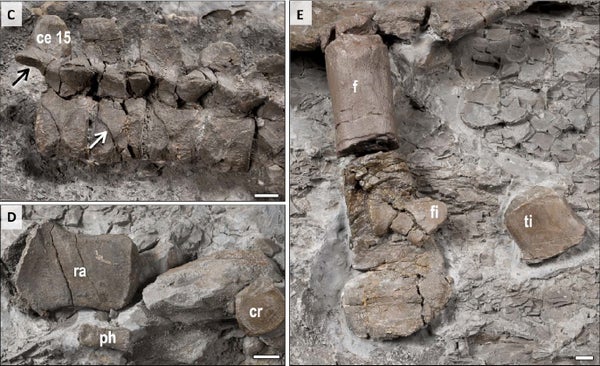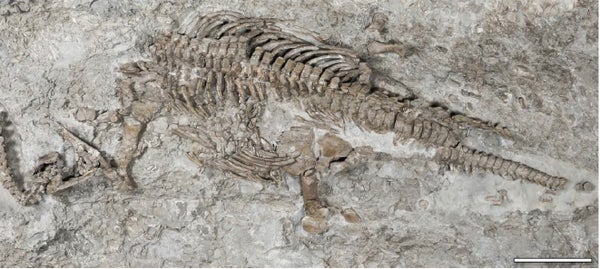This article was published in Scientific American’s former blog network and reflects the views of the author, not necessarily those of Scientific American
Plesiosaurs are among the most charismatic reptiles that ever lived. That's why at least a cameo by one of their snaggletoothed members is obligatory in just about any book about prehistoric life. But how did they became such iconic parts of the Mesozoic seas? Until now, it was thought that plesiosaurs originated in the early days of the Jurassic and proliferated for the next 169 million years until their extinction at the end of the Cretaceous. But a new find from Germany draws the plesiosaur story further back into the past.
Rhaeticosaurus mertensi wasn't very big as plesiosaurs go. Paleontologist Tanja Wintrich and colleagues estimate that this marine reptile was about 7.7 feet long in life. But size isn't everything. What makes this fossil so significant are its age and who it's related to.
As you might guess from the animal's name (if you're a bigtime Triassic fan, at least), Rhaeticosaurus lived during the Rhaetian stage of the Triassic. That's about 205 million years ago, and this was thought to be a time before plesiosaurs when the closest thing to them were their pistosaur ancestors. Yet Wintrich and coauthors not only place Rhaeticosaurus among the plesiosaur family, but within a subgroup of large-headed forms called pliosaurs.
On supporting science journalism
If you're enjoying this article, consider supporting our award-winning journalism by subscribing. By purchasing a subscription you are helping to ensure the future of impactful stories about the discoveries and ideas shaping our world today.
So what does this mean? Well, not only did plesiosaurs evolve earlier than thought, but their initial diversification - the split between the long-necked, small-headed forms and the big-headed pliosaurs - must have already happened by 205 million years ago. Rather than springing up after the mass extinction that marked the end of the Triassic, plesiosaurs evolved before that disaster and persisted through it. In other words, these marine reptiles had quite a reach.

Close-ups of the Rhaeticosaurus bones. Credit: Wintrich et al 2017
Name: Rhaeticosaurus mertensi
Meaning: Rhaeticosaurus means "Rhaetian lizard", after the stage of the Triassic it lived during, and mertensi honors Michael Mertens for finding the fossil..
Age: Triassic, about 205 million years ago.
Where in the world?: North Rhine-Westphalia, Germany.
What sort of organism?: A plesiosaur, being closer to the subgroup known as pliosaurs.
How much of the organism’s is known?: A skeleton, mostly still in articulation.
References:
Wintrich, T., Hayashi, S., Houssaye, A., Nakajima, Y., Sander, P. 2017. A Triassic plesiosaurian skeleton and bone histology inform on evolution of a unique body plan. Science Advances. doi: 10.1126/sciadv.1701144
Previous Paleo Profiles:
The Light-Footed Lizard The Maoming Cat Knight’s Egyptian Bat The La Luna Snake The Rio do Rasto Tooth Bob Weir's Otter Egypt's Canine Beast The Vastan Mine Tapir Pangu's Wing The Dawn Megamouth The Genga Lizard The Micro Lion The Mystery Titanosaur The Echo Hunter The Lo Hueco Titan The Three-Branched Cicada The Monster of Minden The Pig-Footed Bandicoot Hayden's Rattlesnake Demon The Evasive Ostrich Seer The Paradoxical Mega Shark The Tiny Beardogs The Armored Fish King North America's Pangolin The Invisible-Tusked Elephant The Mud Dragon The Spike-Toothed Salmon The Dream Coast Crocodile Buriol's Robber Ozimek's Flyer The Northern Naustoceratopsian The High Arctic Flyer The Tomatillo From the End of the World The Short-Faced Hyena The Mighty Traveler from Egg Mountain Keilhau's Ichthyosaur Mexico's Ancient Horned Face Mauricio Fernández's Plesiosaur New Zealand's Giant Dawn Penguin The Orange Sea Lion Mongolia's Ginkgo Cousin The Geni River Frog Isabel Berry's Dinosaur The Whale Caiman The Moab Lizard Yang Zhongjian's Lizard The Little Anubis The Shuangbai Lizard The Wyvern Dinosaur The "Need Helmet" Dinosaur The Jianianhua Dragon The Liaoning Hunter The Dalian Lizard Crompton's Aleodon Jenkins' Amphibian Serpent From the Chinle The Large Ancestor Lizard The Crown Tooth Currie's Alberta Hunter The Elephant Bird Mimic The Crested Thief The Hiding Hunter The Horned Lizard The Silk Bird The Sieve-Toothed Plesiosaur The Defenseless Snout Burian's Lizard The Small Whaitsiid The Beautiful Bird The Fierce Cat The Older One From Melksham The King of the Miocene Iberian Giraffes Miera's Lizard The Traveling Sloth The Sand Whale Shouten's Marsupial Lion
